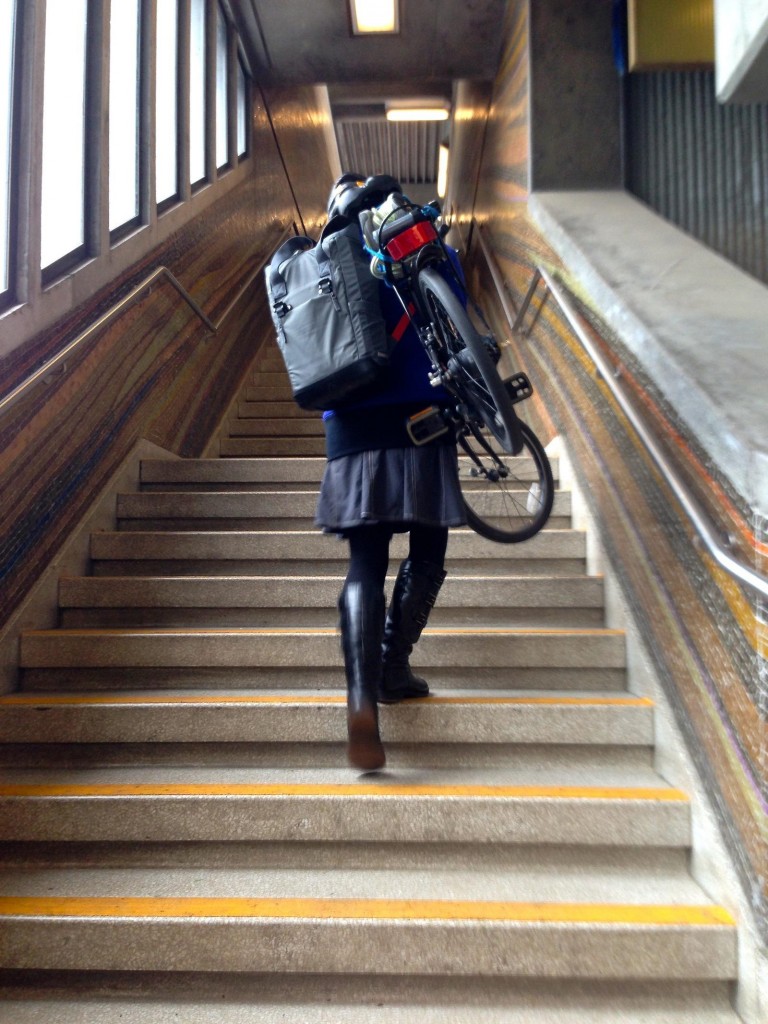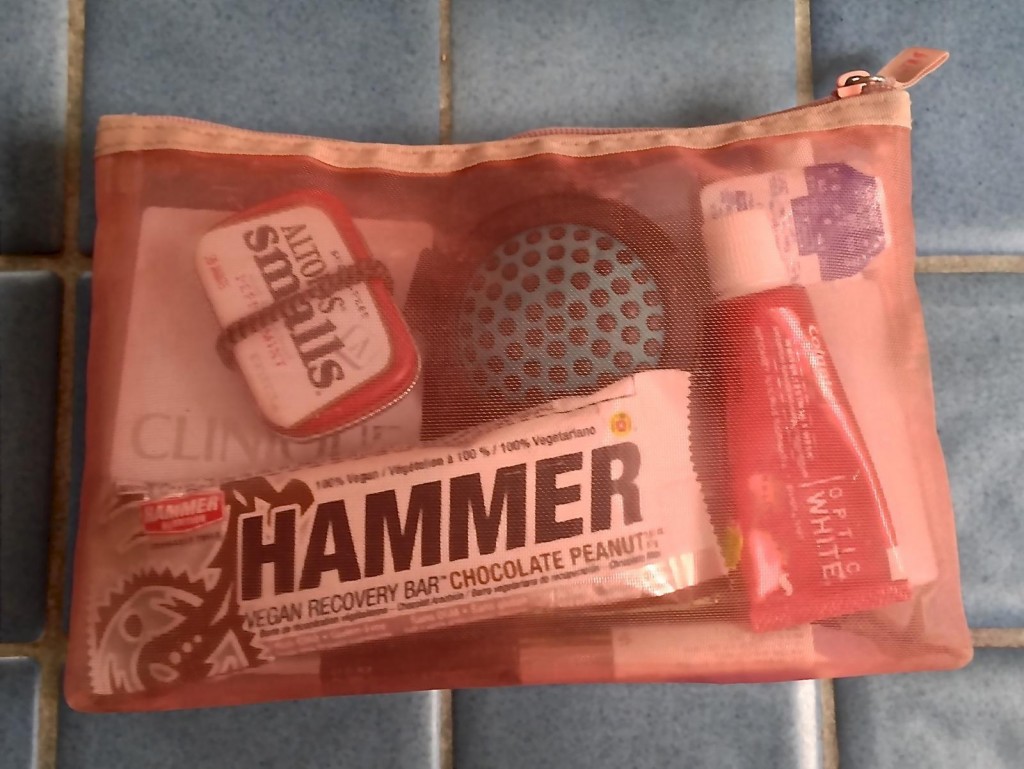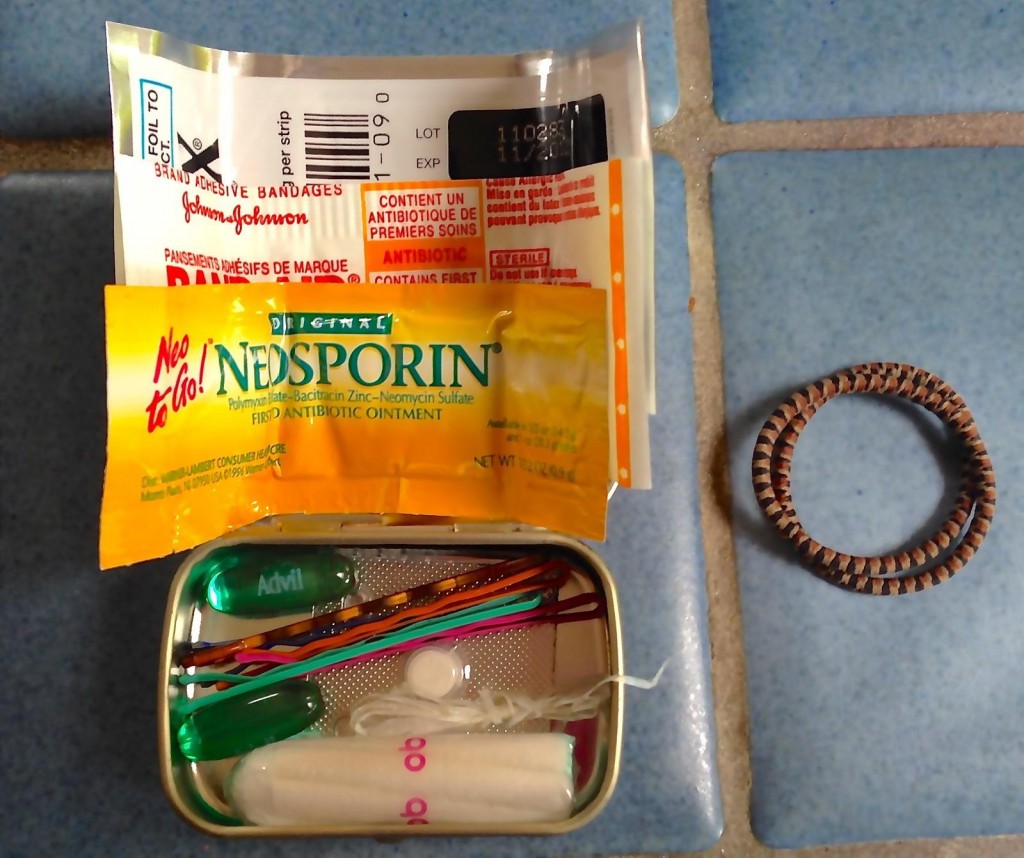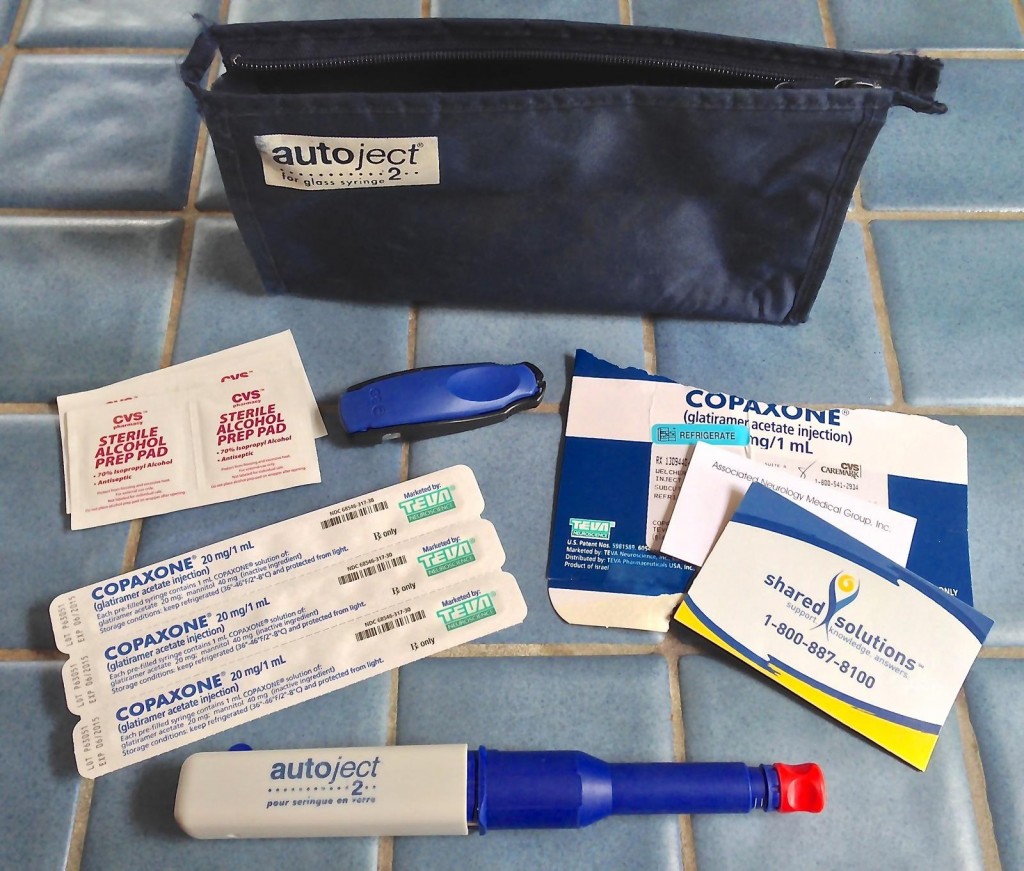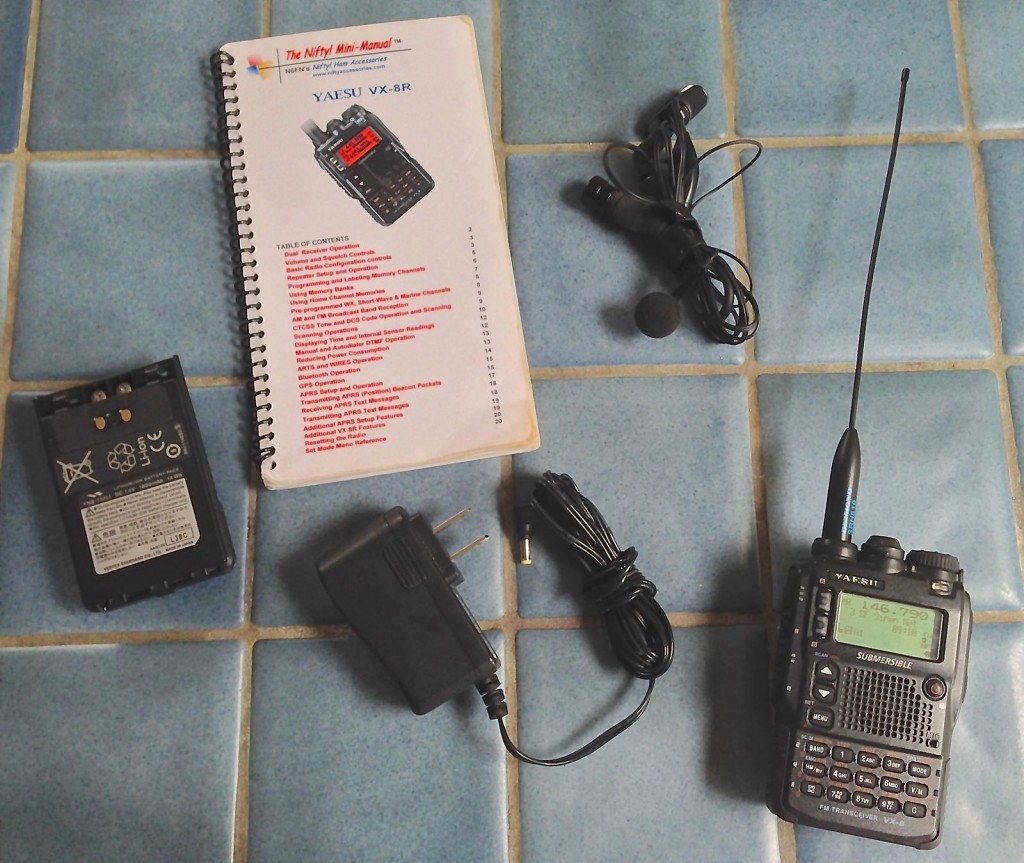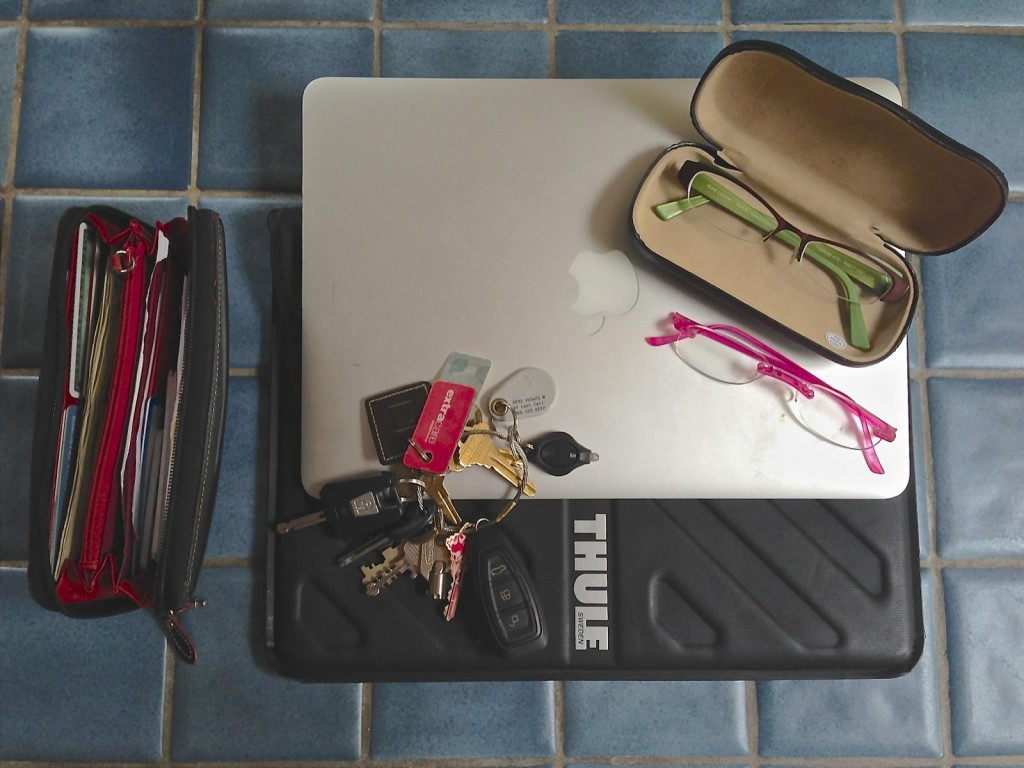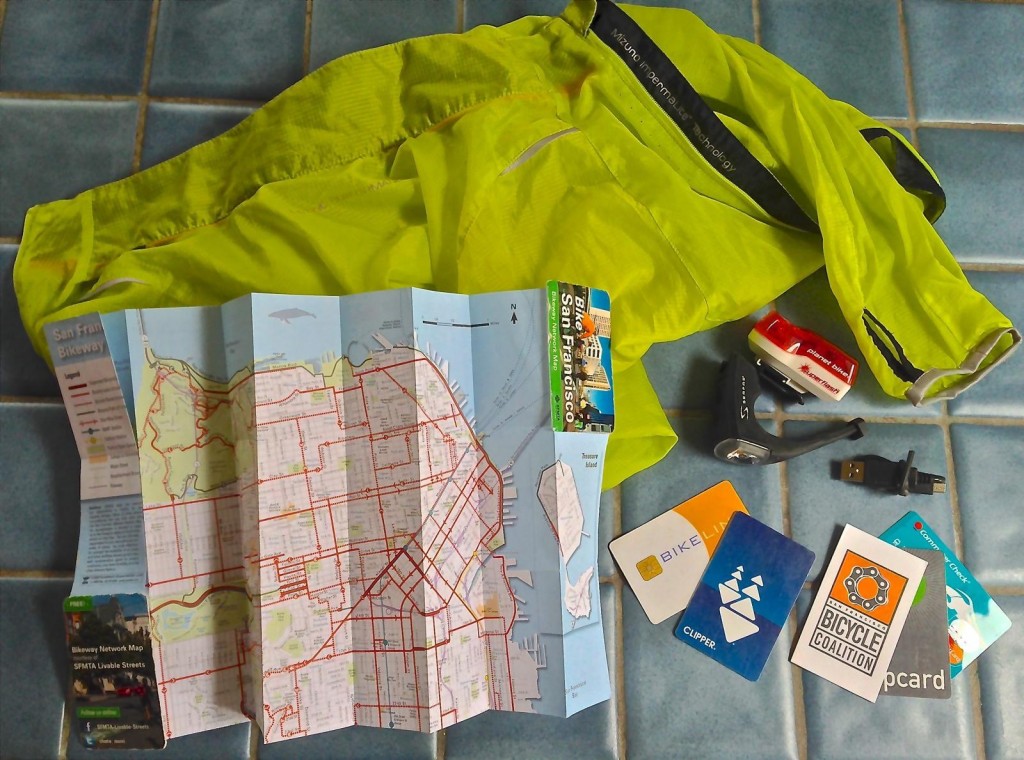What’s in my bag? – Laura Welcher
Bike commuter super transformer bag
By training, I’m a linguist. I’m fascinated by systems, especially complex yet economical ones — like human language — that elegantly solve problems. To feed my inner geek, I look for tricky aspects of daily life that can be improved by the development of such systems, and then put the system together with just what is needed to make it all work just right. And then let it run, with minimal input, like clockwork.
Several years ago I was faced with such an problem by the introduction an extremely annoying 3-hour-a-day commute. Liking my job a lot, but hating being sedentary and stuck in traffic for hours at a time, I decided to ditch the car and become a bike commuter.
However, my particular commute (in the San Francisco Bay Area) presents several challenges. Part of my ride involves either riding BART or taking a bus across the Bay Bridge. This means quickly donning and doffing a bike bag in order to be able to carry the bike up and down BART stairs, through fare gates, being able to maneuver on trains without rolling over packages, paws, or feet, and being able to load the bike on and off the rack on the outside front of the Transbay Bus. Fellow public transit takers are not appreciative of cyclists who are slow or clumsy at doing any of this.
After trying out many commuter bags, some too big and some too small, I think I have found one that is just right. The Ballard Market Pannier ($80) by Detours converts in a flash from a pannier to a backpack, so that you can quickly secure it on your back and carry your bike. It also converts to a long-handled tote bag so you can travel as an incognito bike commuter as needed. The pack is rugged, the base is waterproof, there are internal straps and clips to secure a laptop and keys, and there is a cover you can whip out in wet weather to keep everything inside clean and dry. It fits on both my standard hybrid commute bike, as well as my folding Dahon Vitesse bike ($530-$750) shown here.
[Click images to embiggen]
And now for what is inside. One basic challenge that most bike commuters have is the need to be able to transition from casual bike commuter wear (which San Francisco workplaces are generally tolerant of), to “event-wear” for special activities or meetings at work, where one attempts to banish the sweat and bike helmet-hair for a look that is a bit more polished and put-together. I am no exception to this.
Besides carrying a change of clothing, my secret weapon is this small mesh bag with all of the essential elements to produce the transformation. They allow it to be accomplished anywhere from a seat in the back of the bus, to a work desktop, to the least equipped of public bathrooms. Also stashed in this bag are a variety of necessities including basic tools, toiletries, and first aid to handle most minor commute and workday emergencies.
This bag also includes a small Altoids tin that neatly packs in the smallest (and somewhat sensitive) health and beauty items. I keep it closed with a hair elastic.
- Mesh zipper bag
- Beauty kit:
- Pop-up hair brush ($18)
- Bare Minerals Mini SPF 20 Concealer ($5) and Baby Buki mini kabuki brush ($6). Especially handy for photo and film shoots so you don’t become victim to whatever germ-infested, skin rash-inducing supplies the camera-wielder has on hand and likely has used on hundreds of other people’s faces.
- Bare Minerals Lip Liner ($16), Eye Liner ($17) (also good for brows), Liner Brush ($22)
- Clinique Mascara, Mirror Compact ($23)
- Aveda Lip Glaze ($18)
- Artstar mini hair clasp
- Bobby pins in assorted colors
- Hair elastic (doubles as a way to keep the Mini Altoids tin securely closed)
- Plastic spray bottle (empty — fill with water as needed for quick hair fixes)
- Drinkables: Teabags in individual wrappers (plastic wrappers are the most durable), packets of Starbucks Via instant coffee ($31/50-pack)
- Health kit:
- Emergen-C packet ($28/90-pack) (vitamin C drink powder)
- Mini Altoids Tin
- Band-aid bandage
- Neo To Go single-use packet ($49/gross) (Neosporin antiseptic ointment)
- GasX Thin Strip ($5/18-pack) (doubles as an emergency breath mint)
- Claritin ($29/70 tablets) (if there is a cat in the room, it will find me)
- Asthma inhaler (did I mention if there is a cat in the room, it will find me?)
- Spare contact lenses
- Advil Liqui-gel ibuprofin ($13/160 capsules) (work super fast on the worst of headaches, especially when used at the same time as a Starbucks Via packet)
- OB tampon($11/40) (women love these because they are so small and stowable. When there was a temporary supply shortage a couple of years ago, things almost got really, really ugly.)
- Toothbrush, travel tube of toothpaste, and a little bundle of dental floss (which no MacGyver kit should be without, and of course one should never underestimate the importance of good oral hygiene).
- Bike tools:
- Novara “Never a Bad Time to Ride” reflective velcro pant leg strap
- Plastic bike tire lever ($5/3) (tough but lightweight)
- Mini tire patch kit ($4)
- Crank Brothers bike multi-tool ($20) (not lightweight but doubles as self-defense)
- Spare AAA batteries for rear bike light
- Other tools: Buck Metro Knife ($17), Mini Multi-tool ($2)
- Quick calories for long runs or long events (see below):
- Clif Shot Bloks ($29/18)
- Hammer Vegan Recovery Bar ($33/12) (tastes surprisingly good post-run)
Another challenge that I have to deal with is the need to take a shot. I’m supposed to take it every day, ideally at the same time each day. The only time I can manage to be consistent about it is around 10 am, so I usually carry the shot bag with me. Afterwards the shot site can hurt like heck so it is really better to do after the bike ride when it can be iced for a bit. I wanted to show this picture because I figure a lot of people have to deal with something like it, and to show that it can be dealt with. (My shot is for M.S. but it is more common challenge for diabetics.) Not fun and not fair, but having to take a shot doesn’t need to keep you off your bike if that’s what you want to do. And, managing it well within my larger bike commute system adds a touch of elegance to my solution, imho.
- BD Safe-Clip ($3) needle-nipper. A fantastic and inexpensive device — it safely removes and stores hundreds of needles as biohazard waste; the rest of the syringe materials can go into regular recycling. Disposing of used syringes was a huge pain until I figured this out.
- Copaxone — a treatment for M.S. and quite possibly the reason I can still bike (and work and walk and run) today. I usually keep several syringes in the bag so I don’t have to restock every day.
- Autoject ($34) — mechanical injection tool that hides the needle (a big help for the needle-phobic) and for those hard-to-reach injection sites.
- Prescription and doctor contact info, 1-800 number for advice.
- Individual alcohol prep pads ($5/200) — turns out these are also incredibly useful for cleaning all kinds of things, but especially grungy mobile phones and computer keyboards.
The next system of gear I carry in my bag is part fun, part communications experiment (nerdy linguist fun), and part civic service in a location where a major earthquake could happen at any moment. This set of stuff is my portable amateur radio gear. Using this radio, I can talk point-to-point with other radio users, hop on one of the several local volunteer-maintained repeaters, and in an emergency (when cell networks often go down), join or run an alternate communications network and pass emergency messages using established and well-known protocols. I often practice on Tuesdays with a radio net that convenes on a local repeater after the San Francisco emergency sirens are tested.
- Yaesu VX-8DR HT Radio ($492)
- AC charger, earphone mic, charged extra LI-ON battery. Another good practice is to carry an alkaline battery case and spare batteries and / or a cigarette lighter plug ($28). These aren’t in my current kit but probably should be, because they extend use of the radio in an emergency. Without recharging, I can currently get about 8 continuous hours of use in receive mode, but considerably less if I need to a lot of transmitting.
- Nifty Mini-Manual — laminated quick guide to the VX-8DR for reading on the BART / bus or looking up a function (this particular radio has lots of functions, and many involve multiple key-push combinations).
- Diamond SRH519 ($23) flexible antenna which so far has held up to a lot of abuse in my bag and allows the radio to be comfortably carried, either clipped on the bag or on the belt / waistline. I’ve also used the Diamond SRHF40 flexible antenna with good results.
A more recent gear / bag challenge I had involved maintaining a training schedule this past spring to complete my first marathon. On an event day at work, this could mean biking to work in the morning, working a regular day, heading out from work to complete a 5 – 8 mile run, returning to work to get ready for an event (and cleaning up sans shower), working the event, getting back into commute gear, and then biking home. Now that the marathon is done, I want to keep up my endurance and training level to run more of them. So, the stuff I carry with me needs to support days like this.
- Garmin 620 sports watch with heart rate monitor ($450).
- Nuun Energy hydration tabs ($42/80 tablets) (with B Vitamins and a little kick of caffeine).
- Wash cloth
- Run Guard anti-chafe stick, travel size ($6) (as someone who runs in races and has also worked radio support at the medical stations, believe me you always want to bring your own chafe stick — you really don’t want to dip into the big communal jar of vaseline!)
- Deodorant, travel size — I use it for my friends.
- Tifosi Slip sunglasses ($50), with interchangeable polarized lens. All-purpose, but especially good for biking and running.
- Nathan water bottle ($15) — I don’t carry a bottle like this with me when I run, but do sip from it throughout the day to stay hydrated, especially on running days. This one has no annoying squeaky sound when you take a sip like some water bottles, and it isn’t prone to leaking.
The workday essentials (ok, I admit the wallet and key ring need a bit of editing)…
- LaFont Topaze prescription lenses and Jellies readers ($21)
- Key chain with too many keys
- Overstuffed wallet
- MacBook Air laptop ($900) — has held up well to regular abuse, probably because of…
- Thule Gauntlet padded waterproof laptop sleeve ($36)
And last, but not least — the gear to support the commute itself. I keep the SF Bike map because of its paper charm, also because I like to look at it while riding BART or the bus (such a pretty system!). It folds down to wallet size. I show the various cards here (some are normally in my wallet) because they demonstrate whole other systems of infrastructure that operate in the background to efficiently maintain my ability to bike commute — Clipper Card to quickly pay transit fares, Commuter Check card to quickly restock the Clipper Card with pre-tax dollars, BikeLink card to lock my bike in safe locker storage at most transit stations, and a ZipCar membership to rent a ride share during the workday if need be (for example, to pick someone up or haul stuff). And of course, my card to show I’m a proud member of the San Francisco Bike Coalition!
Btw, this is my summer bike kit; the winter kit is much more involved because of the rain gear. I consider one of the greatest and most delightful challenges to my system to be the ability to maintain comfort, safety and visibility as well as dryness for self and gear during a San Francisco downpour!
- Free folding map of San Francisco bike routes from the SFMTA.
- Planet Bike rear red blinking light ($20), Serfas USB Headlight ($20-$40)
- Mizuno Impermalite women’s lightweight performance shell ($80). Not waterproof, but extremely lightweight and windproof. Also handy for windy runs along the SF Marina.
- Cards: Clipper, BikeLink, ZipCar, Commuter Check, SF Bicycle Coalition Membership.


